Contract Law Assignment: Analyzing Contractual Elements for Curtis
VerifiedAdded on 2023/01/19
|8
|1765
|68
Homework Assignment
AI Summary
This assignment delves into the core principles of contract law, specifically focusing on the elements of offer, acceptance, consideration, and the intention to create legal relations. Through the analysis of a case involving Jasmine and Curtis, the assignment examines whether a legally binding contract was formed. The student explores the presence of offer and acceptance, considering Curtis's initial offer and Jasmine's subsequent agreement. The role of consideration, in the form of payment for services, is also evaluated. Furthermore, the assignment addresses the intention of the parties to be legally bound, assessing whether their actions and discussions indicated a mutual understanding to enter into a contractual agreement. The conclusion determines if all essential elements were met, leading to an enforceable contract.
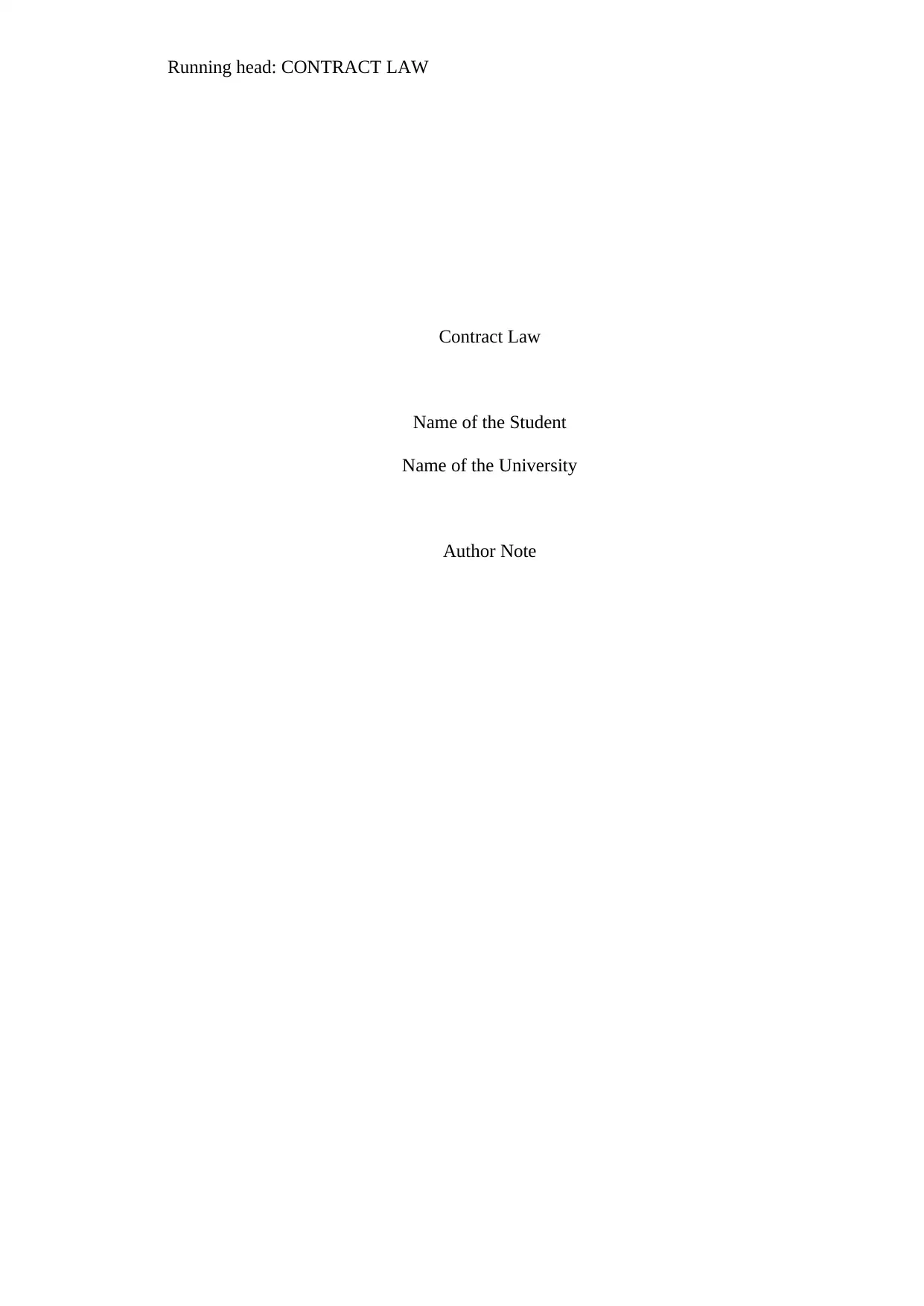
Running head: CONTRACT LAW
Contract Law
Name of the Student
Name of the University
Author Note
Contract Law
Name of the Student
Name of the University
Author Note
Paraphrase This Document
Need a fresh take? Get an instant paraphrase of this document with our AI Paraphraser
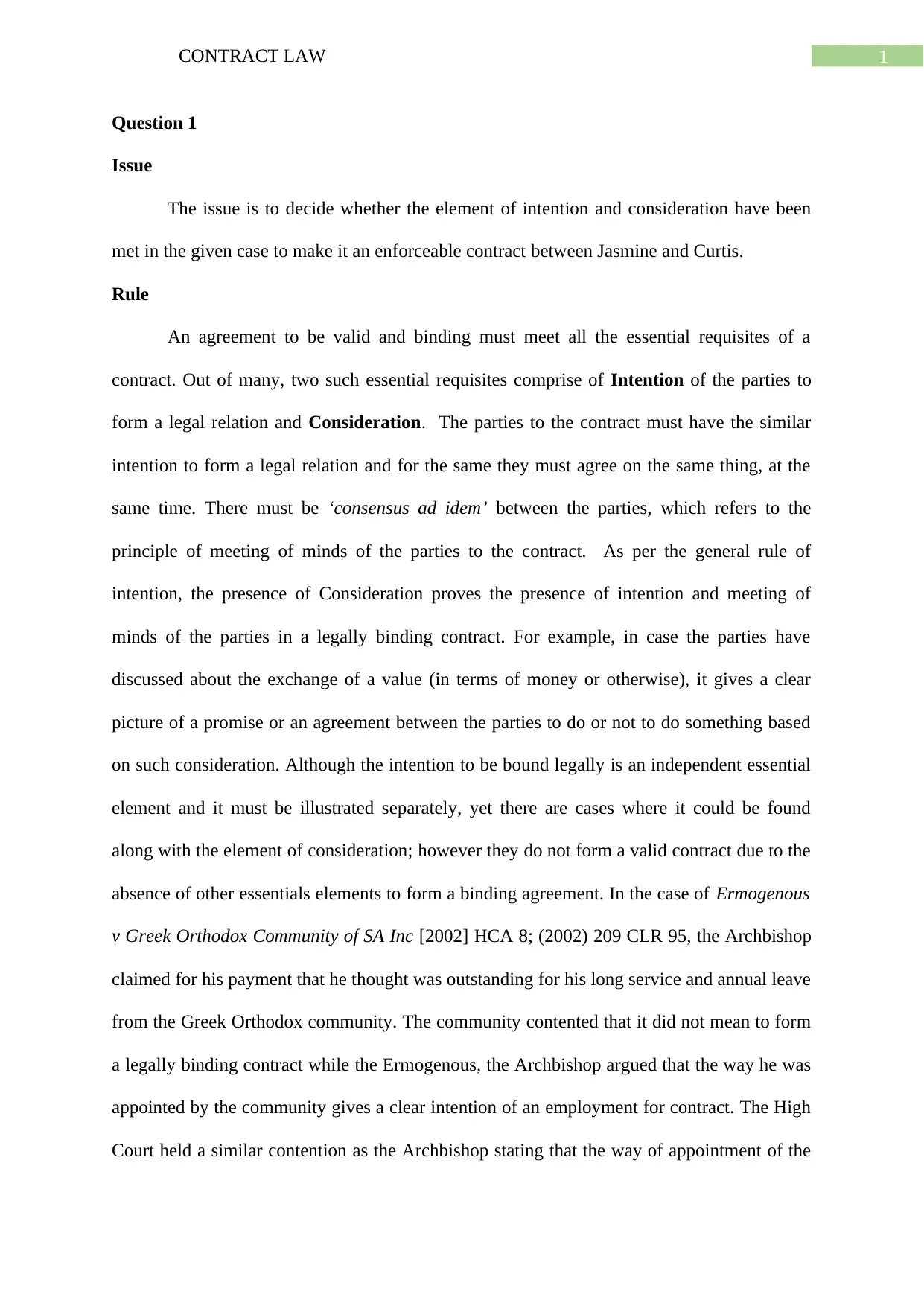
1CONTRACT LAW
Question 1
Issue
The issue is to decide whether the element of intention and consideration have been
met in the given case to make it an enforceable contract between Jasmine and Curtis.
Rule
An agreement to be valid and binding must meet all the essential requisites of a
contract. Out of many, two such essential requisites comprise of Intention of the parties to
form a legal relation and Consideration. The parties to the contract must have the similar
intention to form a legal relation and for the same they must agree on the same thing, at the
same time. There must be ‘consensus ad idem’ between the parties, which refers to the
principle of meeting of minds of the parties to the contract. As per the general rule of
intention, the presence of Consideration proves the presence of intention and meeting of
minds of the parties in a legally binding contract. For example, in case the parties have
discussed about the exchange of a value (in terms of money or otherwise), it gives a clear
picture of a promise or an agreement between the parties to do or not to do something based
on such consideration. Although the intention to be bound legally is an independent essential
element and it must be illustrated separately, yet there are cases where it could be found
along with the element of consideration; however they do not form a valid contract due to the
absence of other essentials elements to form a binding agreement. In the case of Ermogenous
v Greek Orthodox Community of SA Inc [2002] HCA 8; (2002) 209 CLR 95, the Archbishop
claimed for his payment that he thought was outstanding for his long service and annual leave
from the Greek Orthodox community. The community contented that it did not mean to form
a legally binding contract while the Ermogenous, the Archbishop argued that the way he was
appointed by the community gives a clear intention of an employment for contract. The High
Court held a similar contention as the Archbishop stating that the way of appointment of the
Question 1
Issue
The issue is to decide whether the element of intention and consideration have been
met in the given case to make it an enforceable contract between Jasmine and Curtis.
Rule
An agreement to be valid and binding must meet all the essential requisites of a
contract. Out of many, two such essential requisites comprise of Intention of the parties to
form a legal relation and Consideration. The parties to the contract must have the similar
intention to form a legal relation and for the same they must agree on the same thing, at the
same time. There must be ‘consensus ad idem’ between the parties, which refers to the
principle of meeting of minds of the parties to the contract. As per the general rule of
intention, the presence of Consideration proves the presence of intention and meeting of
minds of the parties in a legally binding contract. For example, in case the parties have
discussed about the exchange of a value (in terms of money or otherwise), it gives a clear
picture of a promise or an agreement between the parties to do or not to do something based
on such consideration. Although the intention to be bound legally is an independent essential
element and it must be illustrated separately, yet there are cases where it could be found
along with the element of consideration; however they do not form a valid contract due to the
absence of other essentials elements to form a binding agreement. In the case of Ermogenous
v Greek Orthodox Community of SA Inc [2002] HCA 8; (2002) 209 CLR 95, the Archbishop
claimed for his payment that he thought was outstanding for his long service and annual leave
from the Greek Orthodox community. The community contented that it did not mean to form
a legally binding contract while the Ermogenous, the Archbishop argued that the way he was
appointed by the community gives a clear intention of an employment for contract. The High
Court held a similar contention as the Archbishop stating that the way of appointment of the
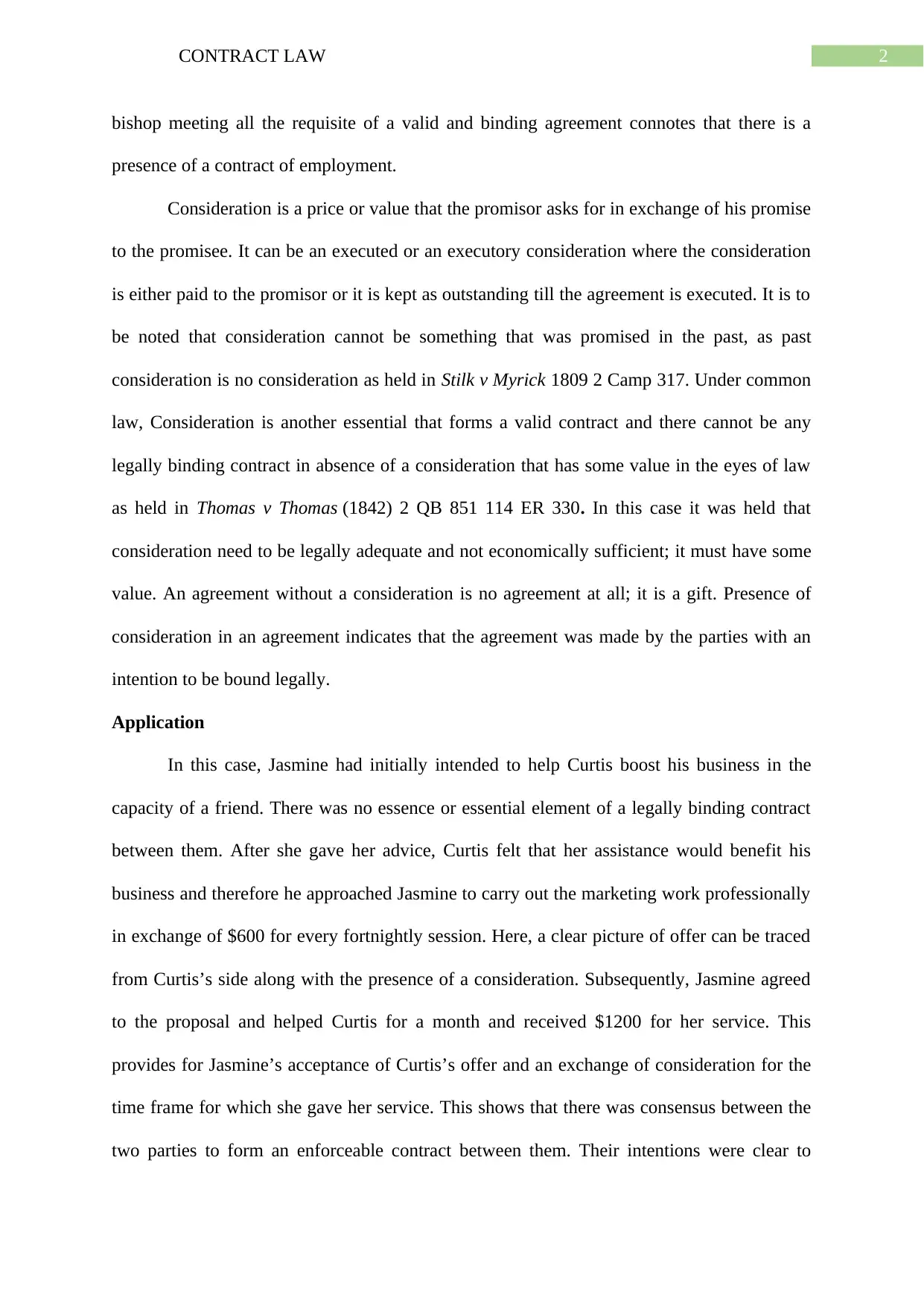
2CONTRACT LAW
bishop meeting all the requisite of a valid and binding agreement connotes that there is a
presence of a contract of employment.
Consideration is a price or value that the promisor asks for in exchange of his promise
to the promisee. It can be an executed or an executory consideration where the consideration
is either paid to the promisor or it is kept as outstanding till the agreement is executed. It is to
be noted that consideration cannot be something that was promised in the past, as past
consideration is no consideration as held in Stilk v Myrick 1809 2 Camp 317. Under common
law, Consideration is another essential that forms a valid contract and there cannot be any
legally binding contract in absence of a consideration that has some value in the eyes of law
as held in Thomas v Thomas (1842) 2 QB 851 114 ER 330. In this case it was held that
consideration need to be legally adequate and not economically sufficient; it must have some
value. An agreement without a consideration is no agreement at all; it is a gift. Presence of
consideration in an agreement indicates that the agreement was made by the parties with an
intention to be bound legally.
Application
In this case, Jasmine had initially intended to help Curtis boost his business in the
capacity of a friend. There was no essence or essential element of a legally binding contract
between them. After she gave her advice, Curtis felt that her assistance would benefit his
business and therefore he approached Jasmine to carry out the marketing work professionally
in exchange of $600 for every fortnightly session. Here, a clear picture of offer can be traced
from Curtis’s side along with the presence of a consideration. Subsequently, Jasmine agreed
to the proposal and helped Curtis for a month and received $1200 for her service. This
provides for Jasmine’s acceptance of Curtis’s offer and an exchange of consideration for the
time frame for which she gave her service. This shows that there was consensus between the
two parties to form an enforceable contract between them. Their intentions were clear to
bishop meeting all the requisite of a valid and binding agreement connotes that there is a
presence of a contract of employment.
Consideration is a price or value that the promisor asks for in exchange of his promise
to the promisee. It can be an executed or an executory consideration where the consideration
is either paid to the promisor or it is kept as outstanding till the agreement is executed. It is to
be noted that consideration cannot be something that was promised in the past, as past
consideration is no consideration as held in Stilk v Myrick 1809 2 Camp 317. Under common
law, Consideration is another essential that forms a valid contract and there cannot be any
legally binding contract in absence of a consideration that has some value in the eyes of law
as held in Thomas v Thomas (1842) 2 QB 851 114 ER 330. In this case it was held that
consideration need to be legally adequate and not economically sufficient; it must have some
value. An agreement without a consideration is no agreement at all; it is a gift. Presence of
consideration in an agreement indicates that the agreement was made by the parties with an
intention to be bound legally.
Application
In this case, Jasmine had initially intended to help Curtis boost his business in the
capacity of a friend. There was no essence or essential element of a legally binding contract
between them. After she gave her advice, Curtis felt that her assistance would benefit his
business and therefore he approached Jasmine to carry out the marketing work professionally
in exchange of $600 for every fortnightly session. Here, a clear picture of offer can be traced
from Curtis’s side along with the presence of a consideration. Subsequently, Jasmine agreed
to the proposal and helped Curtis for a month and received $1200 for her service. This
provides for Jasmine’s acceptance of Curtis’s offer and an exchange of consideration for the
time frame for which she gave her service. This shows that there was consensus between the
two parties to form an enforceable contract between them. Their intentions were clear to
⊘ This is a preview!⊘
Do you want full access?
Subscribe today to unlock all pages.

Trusted by 1+ million students worldwide

3CONTRACT LAW
perform or execute the agreement as per their mutual discussion. All of these factors, that is,
the intention of the parties as well as the prevalent consideration clearly vouch for the fact
that there has been a legally binding agreement between them.
Conclusion
Therefore, the essential element of intention and consideration have been met in the
given case to make it an enforceable contract between Jasmine and Curtis.
perform or execute the agreement as per their mutual discussion. All of these factors, that is,
the intention of the parties as well as the prevalent consideration clearly vouch for the fact
that there has been a legally binding agreement between them.
Conclusion
Therefore, the essential element of intention and consideration have been met in the
given case to make it an enforceable contract between Jasmine and Curtis.
Paraphrase This Document
Need a fresh take? Get an instant paraphrase of this document with our AI Paraphraser
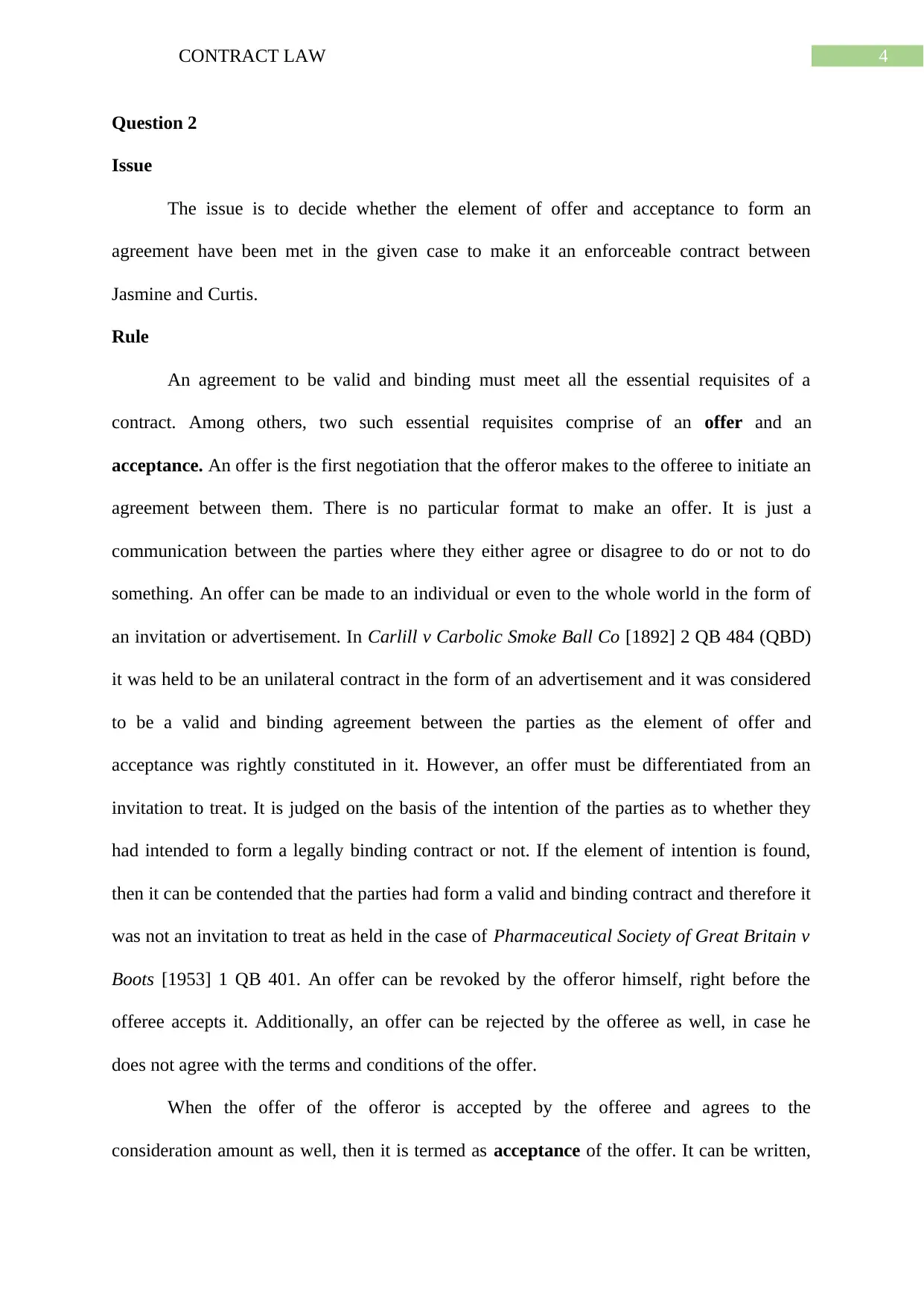
4CONTRACT LAW
Question 2
Issue
The issue is to decide whether the element of offer and acceptance to form an
agreement have been met in the given case to make it an enforceable contract between
Jasmine and Curtis.
Rule
An agreement to be valid and binding must meet all the essential requisites of a
contract. Among others, two such essential requisites comprise of an offer and an
acceptance. An offer is the first negotiation that the offeror makes to the offeree to initiate an
agreement between them. There is no particular format to make an offer. It is just a
communication between the parties where they either agree or disagree to do or not to do
something. An offer can be made to an individual or even to the whole world in the form of
an invitation or advertisement. In Carlill v Carbolic Smoke Ball Co [1892] 2 QB 484 (QBD)
it was held to be an unilateral contract in the form of an advertisement and it was considered
to be a valid and binding agreement between the parties as the element of offer and
acceptance was rightly constituted in it. However, an offer must be differentiated from an
invitation to treat. It is judged on the basis of the intention of the parties as to whether they
had intended to form a legally binding contract or not. If the element of intention is found,
then it can be contended that the parties had form a valid and binding contract and therefore it
was not an invitation to treat as held in the case of Pharmaceutical Society of Great Britain v
Boots [1953] 1 QB 401. An offer can be revoked by the offeror himself, right before the
offeree accepts it. Additionally, an offer can be rejected by the offeree as well, in case he
does not agree with the terms and conditions of the offer.
When the offer of the offeror is accepted by the offeree and agrees to the
consideration amount as well, then it is termed as acceptance of the offer. It can be written,
Question 2
Issue
The issue is to decide whether the element of offer and acceptance to form an
agreement have been met in the given case to make it an enforceable contract between
Jasmine and Curtis.
Rule
An agreement to be valid and binding must meet all the essential requisites of a
contract. Among others, two such essential requisites comprise of an offer and an
acceptance. An offer is the first negotiation that the offeror makes to the offeree to initiate an
agreement between them. There is no particular format to make an offer. It is just a
communication between the parties where they either agree or disagree to do or not to do
something. An offer can be made to an individual or even to the whole world in the form of
an invitation or advertisement. In Carlill v Carbolic Smoke Ball Co [1892] 2 QB 484 (QBD)
it was held to be an unilateral contract in the form of an advertisement and it was considered
to be a valid and binding agreement between the parties as the element of offer and
acceptance was rightly constituted in it. However, an offer must be differentiated from an
invitation to treat. It is judged on the basis of the intention of the parties as to whether they
had intended to form a legally binding contract or not. If the element of intention is found,
then it can be contended that the parties had form a valid and binding contract and therefore it
was not an invitation to treat as held in the case of Pharmaceutical Society of Great Britain v
Boots [1953] 1 QB 401. An offer can be revoked by the offeror himself, right before the
offeree accepts it. Additionally, an offer can be rejected by the offeree as well, in case he
does not agree with the terms and conditions of the offer.
When the offer of the offeror is accepted by the offeree and agrees to the
consideration amount as well, then it is termed as acceptance of the offer. It can be written,
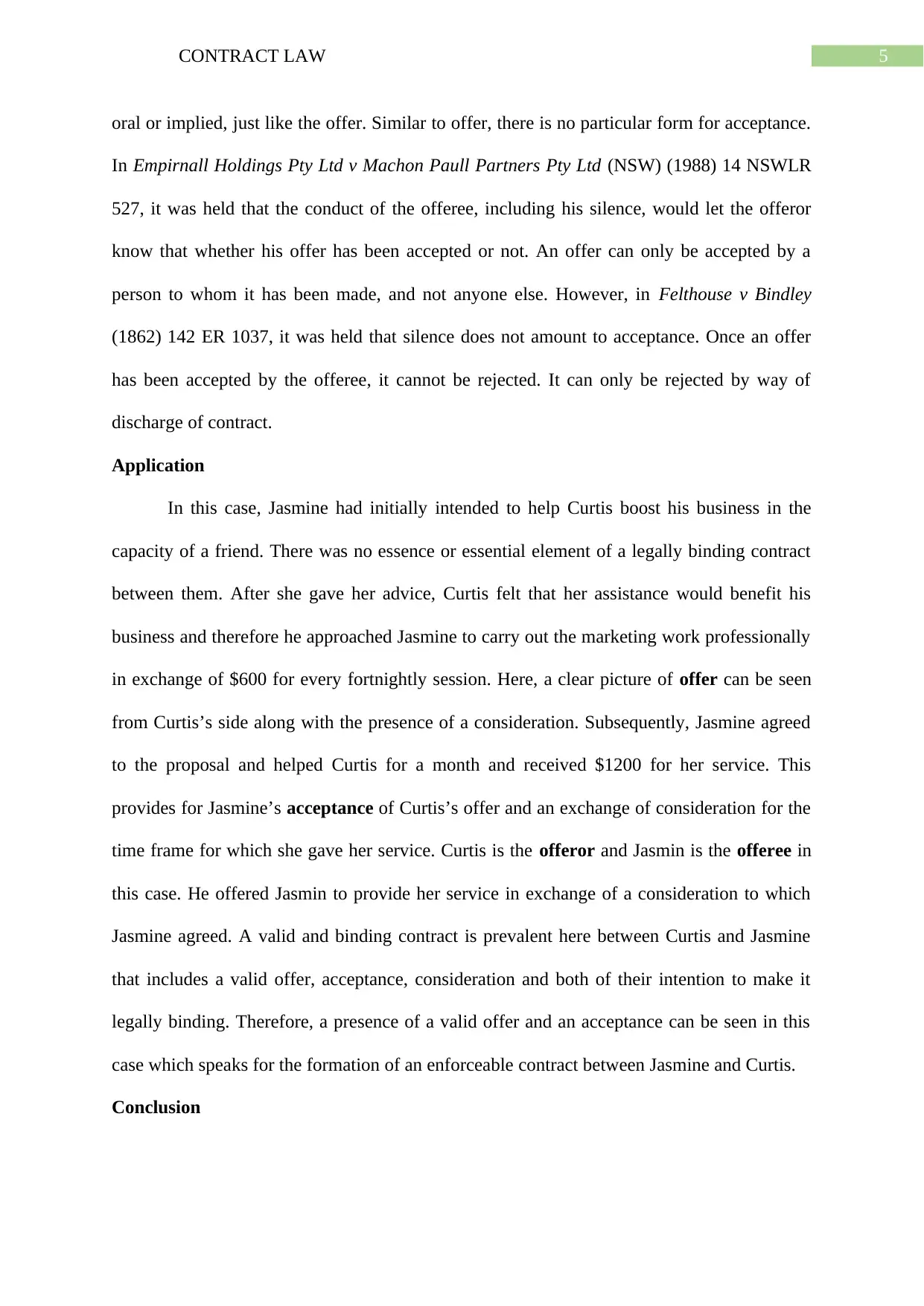
5CONTRACT LAW
oral or implied, just like the offer. Similar to offer, there is no particular form for acceptance.
In Empirnall Holdings Pty Ltd v Machon Paull Partners Pty Ltd (NSW) (1988) 14 NSWLR
527, it was held that the conduct of the offeree, including his silence, would let the offeror
know that whether his offer has been accepted or not. An offer can only be accepted by a
person to whom it has been made, and not anyone else. However, in Felthouse v Bindley
(1862) 142 ER 1037, it was held that silence does not amount to acceptance. Once an offer
has been accepted by the offeree, it cannot be rejected. It can only be rejected by way of
discharge of contract.
Application
In this case, Jasmine had initially intended to help Curtis boost his business in the
capacity of a friend. There was no essence or essential element of a legally binding contract
between them. After she gave her advice, Curtis felt that her assistance would benefit his
business and therefore he approached Jasmine to carry out the marketing work professionally
in exchange of $600 for every fortnightly session. Here, a clear picture of offer can be seen
from Curtis’s side along with the presence of a consideration. Subsequently, Jasmine agreed
to the proposal and helped Curtis for a month and received $1200 for her service. This
provides for Jasmine’s acceptance of Curtis’s offer and an exchange of consideration for the
time frame for which she gave her service. Curtis is the offeror and Jasmin is the offeree in
this case. He offered Jasmin to provide her service in exchange of a consideration to which
Jasmine agreed. A valid and binding contract is prevalent here between Curtis and Jasmine
that includes a valid offer, acceptance, consideration and both of their intention to make it
legally binding. Therefore, a presence of a valid offer and an acceptance can be seen in this
case which speaks for the formation of an enforceable contract between Jasmine and Curtis.
Conclusion
oral or implied, just like the offer. Similar to offer, there is no particular form for acceptance.
In Empirnall Holdings Pty Ltd v Machon Paull Partners Pty Ltd (NSW) (1988) 14 NSWLR
527, it was held that the conduct of the offeree, including his silence, would let the offeror
know that whether his offer has been accepted or not. An offer can only be accepted by a
person to whom it has been made, and not anyone else. However, in Felthouse v Bindley
(1862) 142 ER 1037, it was held that silence does not amount to acceptance. Once an offer
has been accepted by the offeree, it cannot be rejected. It can only be rejected by way of
discharge of contract.
Application
In this case, Jasmine had initially intended to help Curtis boost his business in the
capacity of a friend. There was no essence or essential element of a legally binding contract
between them. After she gave her advice, Curtis felt that her assistance would benefit his
business and therefore he approached Jasmine to carry out the marketing work professionally
in exchange of $600 for every fortnightly session. Here, a clear picture of offer can be seen
from Curtis’s side along with the presence of a consideration. Subsequently, Jasmine agreed
to the proposal and helped Curtis for a month and received $1200 for her service. This
provides for Jasmine’s acceptance of Curtis’s offer and an exchange of consideration for the
time frame for which she gave her service. Curtis is the offeror and Jasmin is the offeree in
this case. He offered Jasmin to provide her service in exchange of a consideration to which
Jasmine agreed. A valid and binding contract is prevalent here between Curtis and Jasmine
that includes a valid offer, acceptance, consideration and both of their intention to make it
legally binding. Therefore, a presence of a valid offer and an acceptance can be seen in this
case which speaks for the formation of an enforceable contract between Jasmine and Curtis.
Conclusion
⊘ This is a preview!⊘
Do you want full access?
Subscribe today to unlock all pages.

Trusted by 1+ million students worldwide

6CONTRACT LAW
Therefore, the element of offer and acceptance to form an agreement have been met in
the given case to make it an enforceable contract between Jasmine and Curtis.
Therefore, the element of offer and acceptance to form an agreement have been met in
the given case to make it an enforceable contract between Jasmine and Curtis.
Paraphrase This Document
Need a fresh take? Get an instant paraphrase of this document with our AI Paraphraser
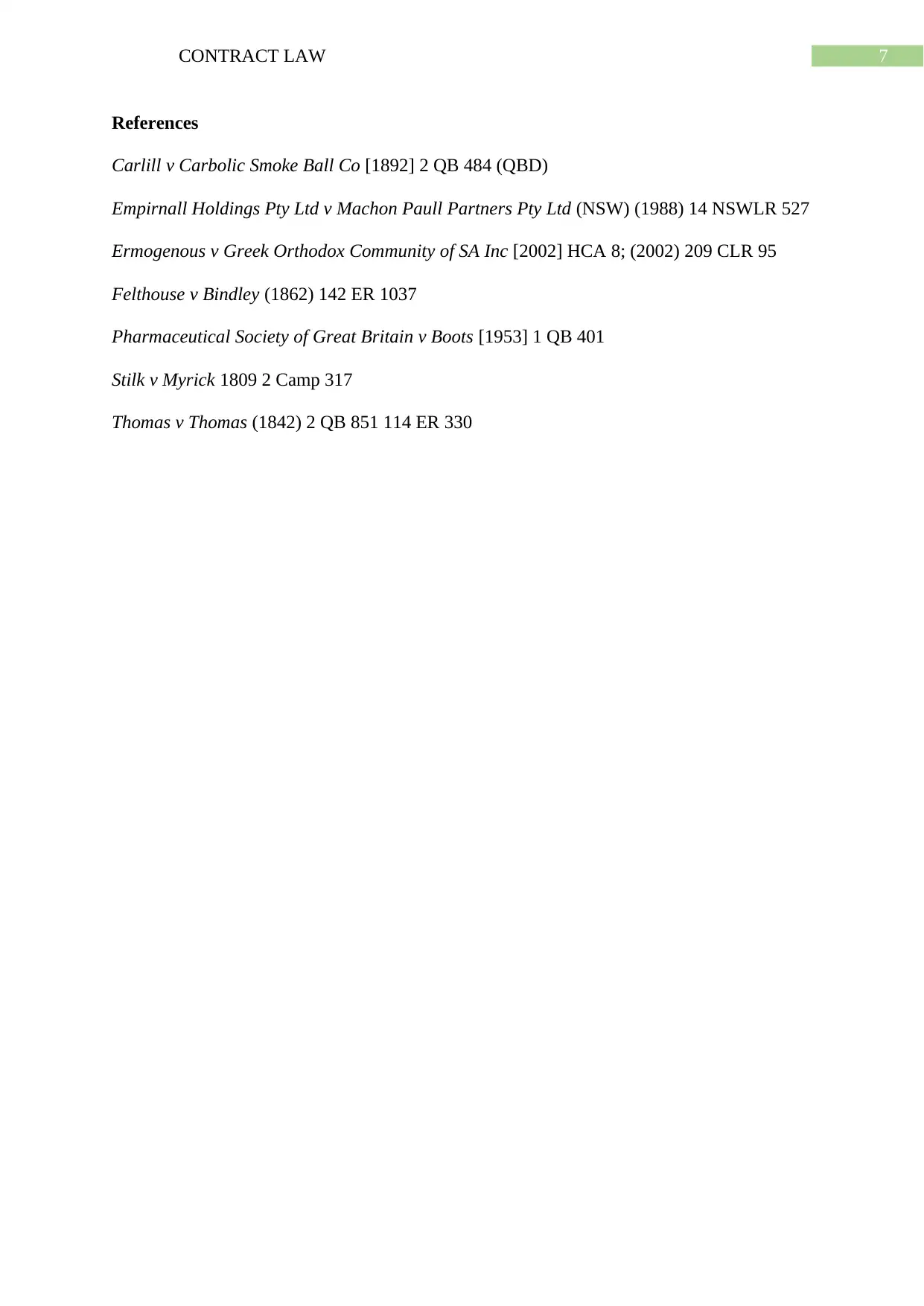
7CONTRACT LAW
References
Carlill v Carbolic Smoke Ball Co [1892] 2 QB 484 (QBD)
Empirnall Holdings Pty Ltd v Machon Paull Partners Pty Ltd (NSW) (1988) 14 NSWLR 527
Ermogenous v Greek Orthodox Community of SA Inc [2002] HCA 8; (2002) 209 CLR 95
Felthouse v Bindley (1862) 142 ER 1037
Pharmaceutical Society of Great Britain v Boots [1953] 1 QB 401
Stilk v Myrick 1809 2 Camp 317
Thomas v Thomas (1842) 2 QB 851 114 ER 330
References
Carlill v Carbolic Smoke Ball Co [1892] 2 QB 484 (QBD)
Empirnall Holdings Pty Ltd v Machon Paull Partners Pty Ltd (NSW) (1988) 14 NSWLR 527
Ermogenous v Greek Orthodox Community of SA Inc [2002] HCA 8; (2002) 209 CLR 95
Felthouse v Bindley (1862) 142 ER 1037
Pharmaceutical Society of Great Britain v Boots [1953] 1 QB 401
Stilk v Myrick 1809 2 Camp 317
Thomas v Thomas (1842) 2 QB 851 114 ER 330
1 out of 8
Related Documents
Your All-in-One AI-Powered Toolkit for Academic Success.
+13062052269
info@desklib.com
Available 24*7 on WhatsApp / Email
![[object Object]](/_next/static/media/star-bottom.7253800d.svg)
Unlock your academic potential
Copyright © 2020–2025 A2Z Services. All Rights Reserved. Developed and managed by ZUCOL.

